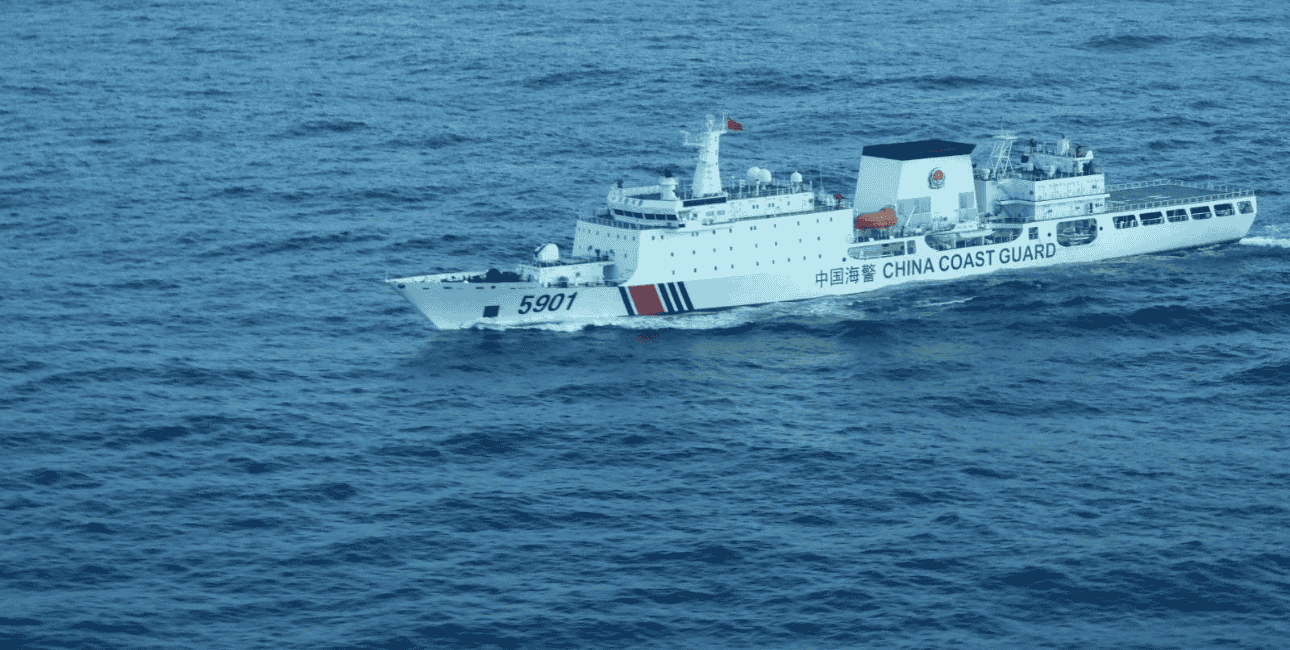Generally, the Southeast Asian countries are at the receiving end of the Chinese Coast Guard’s aggressive tactics. But an Indian Coast Guard Ship returning from a goodwill visit from Japan was shadowed by a Chinese Coast Guard vessel as it passed west of the disputed Scarborough Shoal.
This is happening as the “Monster Ship” of the Chinese Coast Guard is engaged in a confrontation with the Philippines Coast Guard Vessels.
In the last few years, the Chinese Coast Guard, which operates close to over 1,275 hulls while defending “China’s territorial sovereignty and maritime rights and interests,” has started operating in the “gray zone” and poses a significant security challenge in the Indo-Pacific.
The Chinese Coast Guard has 225 ships of over 500 tons capable of operating offshore and additional vessels confined to closer waters. China possesses two of the world’s largest coast guard ships, each weighing 10,000 tons at full load.
The Chinese Coast Guard’s Zhataou-class patrol vessel is the world’s biggest armed coast guard cutter, larger than the US Navy’s Arleigh Burke-class destroyer. More than the size of its vessel is its coercive tactics that “deliberately” stop short of war, which has been a conundrum for the Southeast Asian countries involved in territorial disputes with China.
Ray Powell is the Director of SeaLight, a maritime transparency initiative of the Gordian Knot Centre for National Security Innovation at Stanford University, posted on X: “India Coast Guard Ship ICGS Shaunak returning from a goodwill visit to Japan is shadowed by China Coast Guard 3304 as it passes west of Scarborough Shoal- even as ‘Monster’ Ship CCG 5901 is engaged with Philippines Coast Guard BRP Gabriella Silang east of the shoal.”
The Monster goes dark from time to time, switching off its AIS (automatic Identification system), making it difficult to trace its movements.

The CCG 5901, notorious for its imposing size, continued its pursuit of the Philippine ship approximately 90 nautical miles west of Luzon, well within the Philippines’ Exclusive Economic Zone (EEZ). Powell said that the US Navy’s P-8A Poseidon and MQ-4C Triton are observing these developments.
The Indian ship is passing through the waters that lie within the Philippines’ Exclusive Economic Zone, a claim that China refutes. Two additional Chinese coast guard ships, CCG 3103 and CCG 3502, were present as the Indian vessel navigated the region.
Powell called the Chinese Communist Party “the most sophisticated state gray-zone actor in history.”
China has turned its coast guard into a paramilitary enforcer. China has rapidly expanded the size of its paramilitary forces—which also include a vast and growing maritime militia—and subordinated them to the People’s Liberation Army.
In 2013, China merged five civil maritime agencies into the unified Chinese Coast Guard, referred to as the Maritime Law Enforcement (MLE). This MLE is congruent with the country’s burgeoning national power.

The Coast Guard was also moved from civilian control to the authority of the Military Commission. With no dearth of budget, China has been augmenting its coast guard’s capability.
“This civil-military fusion complicates our problem since China is using the ambiguous status of these forces—the white hulls of its coast guard and the veneer of “fishing” for its militia—to provide both deniability and the aforementioned pretext to escalate,” Powell said in the past.
India has become a more active player in the South China Sea in recent years. Besides supplying BrahMos supersonic cruise missiles to the Philippines, it is looking to finalize deals to export these anti-ship cruise missiles to Indonesia and Vietnam.
In June 2023, Vietnam became the first country to receive a fully operational light missile frigate from India. As tensions increase between Manila and Beijing, China is looking at India’s foray into the South China Sea with concern.
China is interpreting this activity as part of a larger US-led containment policy in its own geostrategic “backyard.” It is eyeing the Indian Naval presence in the region as unjustified, if not illegitimate.
An August 2023 article from Baijiahao, one of China’s largest blog platforms for independent writers, argues that New Delhi’s approach to the Philippines is part of a broader plan to wrest control of the entire SCS.
After maintaining neutrality for years in the matter of dispute in the South China Sea, it was in May 2019 that the Indian Navy, for the first time, conducted joint exercises with the US, Japanese, and Philippine navies in the region.
This was followed by the Indian Navy conducting military exercises with the navies of Vietnam, the Philippines, Malaysia, Australia, and Indonesia in August 2021. In May 2023, India, for the first time, sent warships to participate in a two-day joint exercise with the navies of seven ASEAN states in the South China Sea.
In 2012, the Philippines took China to a tribunal at the Permanent Court of Arbitration (PCA) and it ruled in favor of Manila in 2016. The tribunal at the Hague adjudicated that China’s claims of historic rights within the nine-dash line, which Beijing uses to demarcate its claims in the South China Sea, were without legal foundation.
India has refrained from commenting on the award. But, at the India-Philippines Foreign Ministers’ Meeting held in June 2023, India abandoned its neutrality. India and the Philippines, in a joint statement, sought peaceful settlement of disputes and adherence to international law, especially UNCLOS and the arbitral award, in the joint statement.
This was the first time India proposed abiding by the award, indicating a significant shift in India’s “neutral” stance on South China Sea disputes.
In August 2023, the Philippine and Indian coast guards inked their first Memorandum of Understanding (MoU) that paved the way for more information sharing in the maritime domain, and the Philippines has displayed a keen interest in military hardware India has to offer – including Advanced Light Helicopter Mk II and the indigenously built warships. This was the first visit of a Filipino Coast Guard chief to India.
The White Chinese Hulls In ‘Grey Zone’
The ‘militarization’ of the China Coast Guard began with the transfer of two type 728 cutters from the PLA-Navy to the Coast Guard in 2007. The two vessels were the largest in the Coast Guard’s fleet at the time.
In March 2017, the Chinese Coast Guard sent its 12,000-ton China Coast Guard (CCG) 3901 cutter on a patrol of the South China Sea. At 12,000 tonnes it is not only the largest cutter in the world but is bigger than the US Navy’s 9,800-ton Ticonderoga-class guided-missile cruisers. Its size earned it the moniker of the “Monster.”
The Chinese government’s change in the Coast Guard Law has further aided the menace of the Coast Guard, evoking concerns from not only Japan and the Philippines but also the US.
The new law stipulates that China’s Coast Guard (CCG) has the authority to respond to situations in which the nation’s sovereignty is infringed.
It allows CCG vessels to use forcible measures, including weapons, against foreign ships that it sees as illegally entering its waters, sparking worries that Japanese ships navigating around the Senkaku Islands will be targeted.




